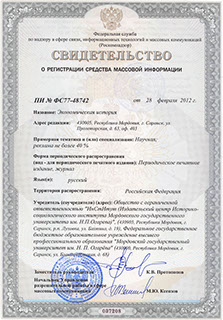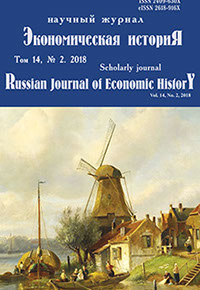Экономическая историЯ
Russian Journal of Economic History
ISSN 2409-630X (Print)
ISSN 2618-916X (Online)
Expert board:
- Scientific Council of RAS on economic history;
- Research and Educational Center «The economic history of Central Russia and the Middle Volga region» of Ogarev Mordovia State University;
- Center of Economic History of Lomonosov Moscow State University
Navigation
Certificate of registration

ISSN 2409-630X (Print), ISSN 2618-916X (Online)
DOI: 10.15507/2409-630X.041.014.201802.155-169
Bakhtiyor А. Alimdjanov
Ph.D., Independent Researcher (Tashkent, Uzbekistan), e-mail: felix_1985@mail.ru
ORCID: http://orcid.org/0000-0002-8251-0201.
HISTORY OF THE MERV BRANCH OF THE RUSSIAN-ASIAN COMMERCIAL BANK
Introduction. In the article the bases of activity and functions of the Merv branch of the Russian-Asian commercial bank (1910–1917) are considered. In the Soviet historiography banks were understood as an instrument of “colonialism”, both Western and Russian. Materials and Methods. The author, based on archival data, proves that the financial institutions of the Russian Empire took into account local specifics and encouraged the production of export-oriented products. The author actively uses interbank correspondence, annual reports of the branch director, as well as audit materials of the Bukhara branch. For the first time in historiography, active and passive operations of the bank were investigated, the expenses and profits of the bank were analyzed, and the bank’s staff was studied. The author, unlike Soviet and post-Soviet researchers, believes that banks have not become “monopolies” in the economy of Central Asia. The largest Russian bank in the region that had an extensive branch network (13 branches) throughout Central Asia was the Russian-Asian Commercial Bank (until 1910 the Russian-Chinese Bank). Results. It should be noted that the Russian-Asian Bank was trying to take control of cotton production and industrial production. But in the end, the bank failed to become the locomotive of the region’s economic development. The main reason, according to the author, is the adaptation by the bank to the really existing economic relations in the Turkestan general-governorship and the khanates. Discussion and Conclusions. The “modernization” of the Central Asian economy in the understanding of banks was to finance export crops and to mediate between the metropolis and the periphery. “Colonial” periphery at first glance seemed an attractive area for investing and receiving superprofits, but the speculative nature of the Turkestan economy prevented the “normal” development of banks. As a result, the economic “modernization” of Central Asia slowed and opened the way for the Soviet experiment.
Keywords: Merv, Central Asia, Turkestan, bank, deposits, promissory note.
For citation: Bakhtiyor A. Alimdjanov. History of the Merv Branch of the Russian-Asian Commercial Bank. Ekonomicheskaya istoriya = Russian Journal of Economic History. 2018; 14(2): 155–169. (In Russ.). DOI: 10.15507/2409-630X.040.014.201801.155-169
© Ogarev Mordovia State University. History and Sociology Institute, 2017
68, Of. 411, Bolshevistskaya St., 430005, The editorial office of the scholarly journal «Russian Journal of Economic History»
Tel.: (8342) 24-25-90; 27-07-11, Fax: (8342) 24-25-90, E-mail: jurnal-econom-hist@isi.mrsu.ru
Designed by A. Napalkov, Email: napalkov@isi.mrsu.ru

